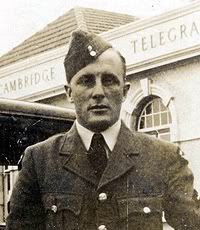
Donald James MACKIE
Known as Don
Serial Number: NZ404080
RNZAF Trade: Air Gunner
Date of Enlistment: 27th of October 1940
Date of Demob: 30th of July 1945
Rank Achieved: Warrant Officer
Flying Hours: 350 Aircrew Productive Hours
Operational Sorties: UnknownDate of Birth: 28th of February 1915, at Matamahoe
Personal Details: Don was the son of Mr. and Mrs. C.J. Mackie who during the war lived at Whitehall, Cambridge. He was educated in Cambridge and played rugby in the town as a teen.Don was married to Dorothy Mackie (nee Mormon, known as Dot), and had two daughters, Mary-Jean (now Paterson) and Rosemary. Before the war he had worked on the farm property of Mr H.S. Brunskill of Whitehall, Cambridge, and postwar Don drew a repatriation farm property in the same area.
Service Details: Don joined the RNZAF on the 27th of October 1940, beginning his initial training at the Ground training School, RNZAF Station Levin. He completely his basic training on the 19th of November 1940 and was granted ten days final leave from that day. He went straight home to Cambridge and spent his leave there over Christmas with family and friends.
Leaving Cambridge for Auckland on the evening of the 30th of December 1940, Don headed to Whenuapai where he spent the New Year period and finally embarked for Canada aboard a troopship on the 10th of January 1941. The ship called at Suva, Fiji; Honolulu, Hawaii, and Victoria in Canada before they reached their final port at Vancouver on the 24th of January.
On arrival Don was posted directly to No. 1 Wireless School, which was situated at Montreal, Quebec, where he trained in the use of operating radio equipment , Morse code and other communications skills.
On the 19th of August 1941 Don began the next phase of his training, briefly passing through the K.T.S. at RCAF Station Trenton, and on the 30th of that month he began a course at No. 6 Bombing and Gunnery School, RCAF Station Mountain View. This involved learning all aspects of aerial gunnery and ordnance, flying in various types including the Avro Anson, Fairey Battle, Westland Lysander, Bristol Bolingbroke and Northrop Nomad.
Don's training as a Wireless Operator-Air Gunner was complete by the 6th of October 1941, and he proceeded to 1Y Depot at Halifax, Nova Scotia to join the Royal Air Force Transport Pool, and he embarked on a ship to cross the Atlantic on the 7th of October 1941. Don arrived in Britain on the 17th of that month and went to No. 3 Personnel Reception Centre at Bournemouth, where New Zealand airmen were given an adjustment period to their new climate and surroundings, and wait for their next posting. Don spent Christmas and New Year in Bournemouth, and was finally posted to No. 60 Operational Training Unit on the 4th of January 1942. Sometime during the training in Canada or at No. 60 OTU,
This unit at RAF Leconfield was specifically training men to fly in night fighters, and Don was learning the techniques of flying as a gunner in Bristol Blenheims and the obsolescent Boulton Paul Defiants. He would have crewed up here with a pilot, the two of them forming a team that would work together to hunt night intruders over Britain.
On the 31st of March 1942, Don and his pilot were posted to No. 264 Squadron which was flying Boulton Paul Defiant II's, and was based then at the famous station of RAF Biggin Hill. Two weeks later, on the 14th of April the unit moved to RAF West Malling, staying there till the 1st of May 1942 when they moved again to RAF Colerne.
On the 30th of April the Defiants of the squadron were all taken out of operational service, and in May 1942 the unit began to re-equip with de Havilland Mosquito II night fighters which first became operational with No. 264 Squadron on the 13th of June 1942. However this new type of aircraft did not require a Wireless Operator-Air Gunner, having only a pilot and a radar operator onboard instead. So Don's role was phased out of the squadron, and he was transferred on the 25th of June to No. 288 Squadron at RAF Digby.
No. 288 Squadron was an unusual unit in that it's purpose was to provide target towing for and simulated air attacks on various anti-aircraft artillery units around the Yorkshire and Lincolnshire counties. Though Digby was the home base for the squadron, they had elements based at various airfields including Wellingore, Coleby Grange, Church Fenton, Collyweston, Hutton Cranswick and East Moor. The squadron had a number of aircraft types on strength by the time Don arrived, including Westland Lysanders, Hawker Hurricanes, Bristol Blenheims, Boulton Paul Defiants, Lockheed Hudsons and Airspeed Oxfords.
Don completed his time with No. 288 Squadron on the 4th of May 1943 when he was posted to No. 5 Personnel Despatch Centre at Blackpool, where he awaited a posting overseas. On the 18th of May he embarked on a troops ship at Blackpool, and the following day set sail for West Africa.
Sighting the 'dark continent' on the 1st of June 1943, and actually docking at Freetown on the following day, Don settled into the new climate and surroundings at No. 2 Personnel Reception Centre that West African city. On the 20th of June he arrived at his new posting, which was to No. 200 Squadron. The squadron were at this time flying Lockheed Hudsons, patrolling the Atlantic Ocean seaways, and flying from Yundum, Gambia.
In July 1943 the squadron converted onto the large four-engined Consolidated B-24 Liberator Mk V bombers. They continued to patrol the Atlantic Ocean in search of any signs of the German Navy, especially their deadly U-boat submarines.
Among the aircrew members of No. 200 Squadron were several kiwis, including Charles Weinberg who later lived in Cambridge, and more famously Flying Officer Lloyd Allan Trigg, who was awarded the Victoria Cross posthumously while flying one of the squadron's Liberators in an attack on a U-boat. Trigg had pressed on with the attack despite the U-boat's gun causing severe damage to the aircraft, and on their final run in the crew of the aircraft managed to sink the submarine but sacrificed their own lives in doing so. It was the U-boat captain, one of seven survivors from the vessel who were picked up later and taken prisoner, who insisted that Trigg deserved the VC. It's quite probably that Don knew Lloyd Trigg personally while on this unit.
On the 16th of December 1943 Don's time with No. 200 Squadron and Africa came to an end. He was posted to No. 1 Personnel Despatch Centre at West Kirkby, England, and then he transferred on the 26th of February 1944 to join No. 11 Base, which was part of No. 1 Group, Bomber Command.
Don was posted to RAF Sandtoft, a new satellite station to RAF Lindholme, and he joined No. 1667 Heavy Conversion unit there. This was the only unit based at Sandtoft, and they were flying Handley Page Halifax bombers. It seems that Don was there to join a new bomber crew who were learning the ropes of flying in heavy bombers and he'd soon be going back onto heavy bomber ops.
During this period it seems he was involved in at least three accidents within the space of little more than a fortnight, and one of these seems to have possibly taken place on the 13th of April 1944, as the same pilot as his third crash had an accident that date and it looks like he carried the same crew. The third of these accidents is believed to have taken place on the night of the 26/27th of April 1944.
Don's crew on this flight consisted of:
Flying Officer Clifford Douglas McIvor J/29531 (RCAF, Captain);
Sgt G.A.F. Hearn; (RAF, Flight Engineer)
Sgt J.A. Tarrant 1433903 (Navigator)
Sgt Robert Davidson Jack 1553039 (RAF, Air Bomber)
Sgt John Irons 1361132 (RAF, Wireless Operator-Air Gunner)
F/Sgt Don Mackie NZ404080 (RNZAF, Air Gunner)
Sgt A H King 126829 (RAF, Rear Gunner)They took off in Handley Page Halifax EB146 (coded B) from Sandtoft at 21.56hrs on the night of 26th of April 1944. Their task was to fly a cross-country night navigation exercise. Official records state that whilst cruising at 20,000 feet the outer port engine began to vibrate badly and grew increasingly worse.Don's own memory of the event was that a fuel line had burst at 25,000 feet and as they descended the aircraft entered into a spiral, or spin, at 16.000 feet. The damaged and vibrating engine had completely departed from the wing and fallen off, causing a loss of control due to the imbalances of weight and airflow.
The captain gave the order for the crew to bale out, taking to their parachutes as the aircraft lost height. Four crew members managed to escape the aircraft before it hit terrain. Don Mackie, Sgt Tarrant, Sgt Hearn and Sgt King escaped with their lives. The aircraft then hit the ground in a farm field one mile north of Marshfields, Gloucestershire, and smashed through a drystone wall, breaking up on impact. The three remaining crew members, McIvor, Jack and Irons, all perished in the crash. Marshfields was just a couple of miles from RAF Colerne, the base where Don had previously been stationed.
Tarrant and King received injuries in their landings, and Don himself was by no means out of danger when he got out of the aircraft. His parachute carried him into the top of a tall tree, where he got hung up in the branches and he found himself in danger of strangulation from the rigging lines. He managed to cut away the chute and dropped approximately 40 feet to the ground, with a hard jolt.
The impact caused severe damage, and the momentum meant he rolled into a stream. All three men were listed initially as sustaining only "slight injuries" by the RAF but Don's injuries were in fact quite substantial. It was soon found he had a compression fracture of the eighth Thoracic Vertebrae (i.e. a fractured spine). He had also fractured his left tibia (i.e. broken leg) and sustained damage to the left knee.
All three men who were injured were treated at the RAF Colerne station sick quarters, but Don was later that evening moved to the Royal Air Force Hospital at Melksham. From there it was decided to invalid him home to New Zealand.
On the 8th of May 1944 Don was transferred to Wroughton Hospital, and he had his back and leg plastered on the 20th of May. He was then sent to a convalescent home to rest and recuperate from the trauma of the accident. The leg cast removed on the 13th of July 1944, and the plaster supporting his back injury was removed on the 25th of August 1944. He finally left the convalescent home on the 3rd of November 1944, but where he went to is unknown, probably back to his base to remain on light duties.
His wounds, particularly the knee, were not healing and so it was decided to invalid Don home to New Zealand. Don boarded the Rangitikei on the 10th of February 1945 and arrived back in New Zealand on the 20th of March 1945.
He was posted to the Sick and Wounded Centre at Remuera, on the 21st of May 1945, and was admitted to Auckland Public Hospital where he had further treatment on his knee.
He was eventually released from the hospital and released from RNZAF service, demobbed back into civilian life on the 30th of July 1945. He returned to Cambridge and to the Brunskill family farm at Whitehall. He later managed to secure his own farm in the same area, through the ballot for serviceman's repatriation scheme. He farmed there the rest of his life.
As a result of his successful bale out of the Halifax bomber, Don was made a member of the Irvin parachute's Caterpillar Club in September 1944.
In June 1977 Don returned to England and made it a mission to not only visit Colerne again, but after a four hour tour of the base there as a guest of the RAF, he went and found the very tree that he'd landed in that night. Here are two photos from that visit including one of Don swinging on the branch of 'his' tree.
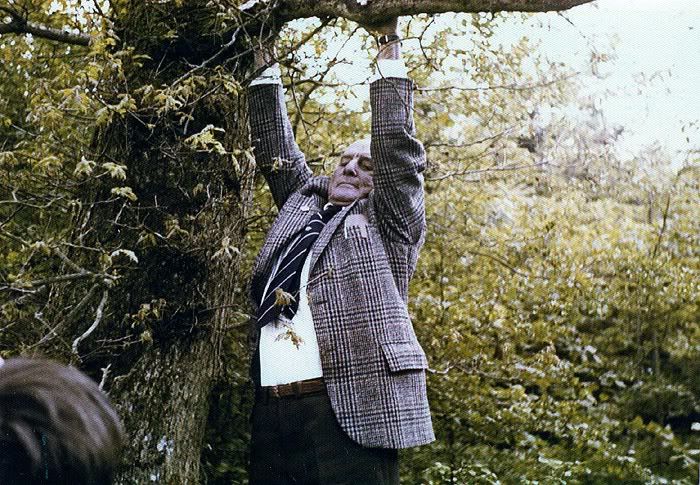
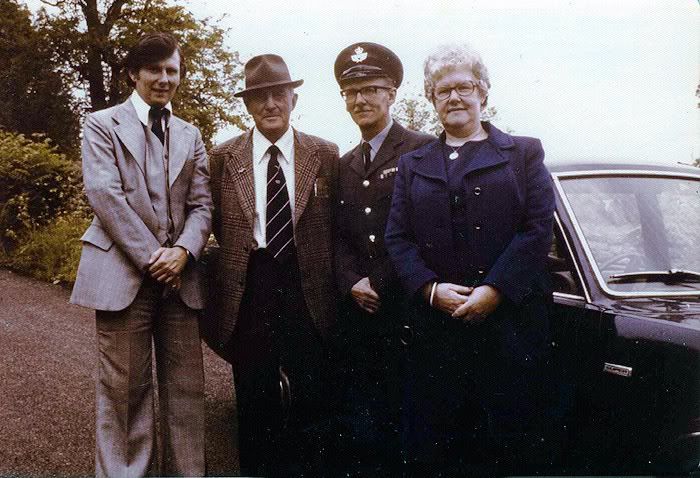
Details of Death: Died 15th of August 1980, aged 65 years
Buried at: Cremated and then interred at Hautapu cemetery on the 30th of August 1980Connection with Cambridge: Don grew up in Cambridge and lived here at Whitehall, Cambridge, till his death
Waikato Independent newspaper reports mentioning Don Mackie:
Air Force Recruit called for training at Levin 21 Oct 1940
Promoted to Warrant Officer 25 Aug 1944
Welcome Home Dance 2 May 1945Thanks to: Don's daughter Mary-Jean Paterson for a significant amount of information on Don's Air Force Career. Also thanks to Kevin Mears and to Henk Welting, who both supplied information on Don's Halifax crash from Bill Chorley's Bomber Command Losses book. Also to other contributors at the Key Historical Aviation Forum, details from the Commonwealth War Graves Commission website, and The Cambridge Museum. Also thanks to Mike Austin, who's father was cousins with Dot Mackie, for the photo below and information supplied.

Above: Don and Dot Mackie (Photo via Mike Austin)
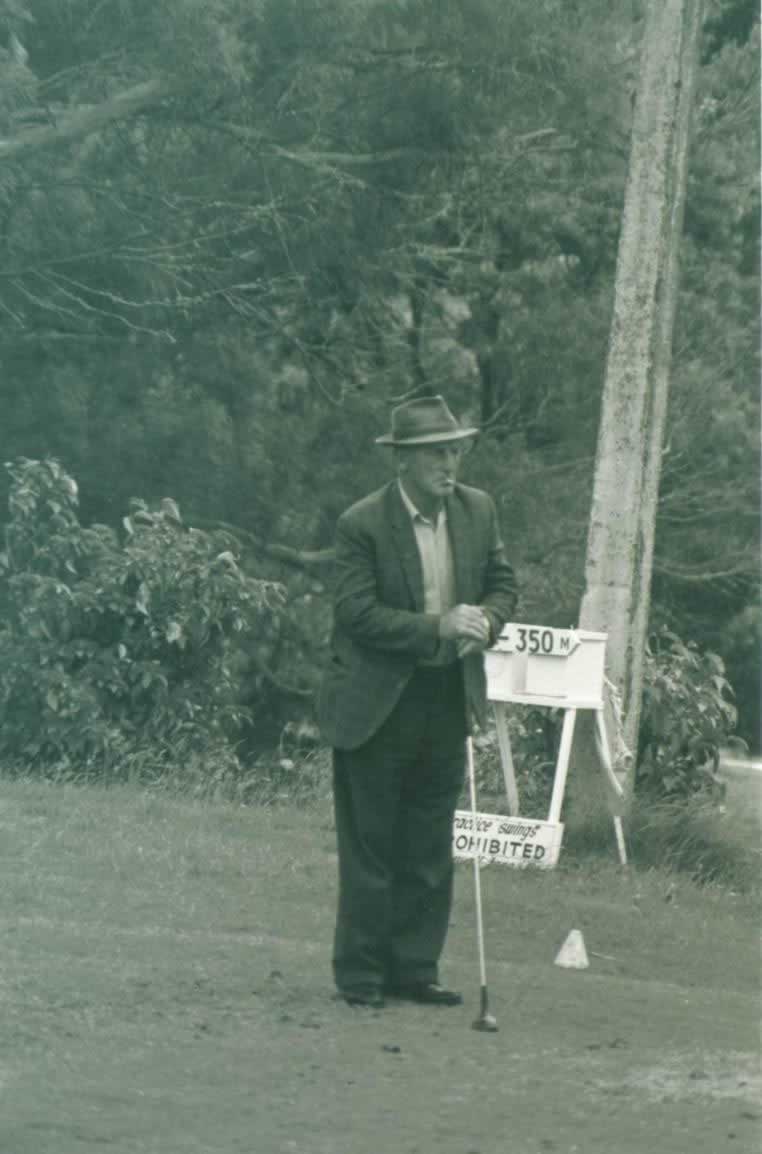
Above: This photo, supplied by the Cambridge Museum, was taken during the Cambridge RSA's 25th Golf Tournament, 12th of November 1967 and shows Don in later life. he was a prominent member of the Cambridge RSA.
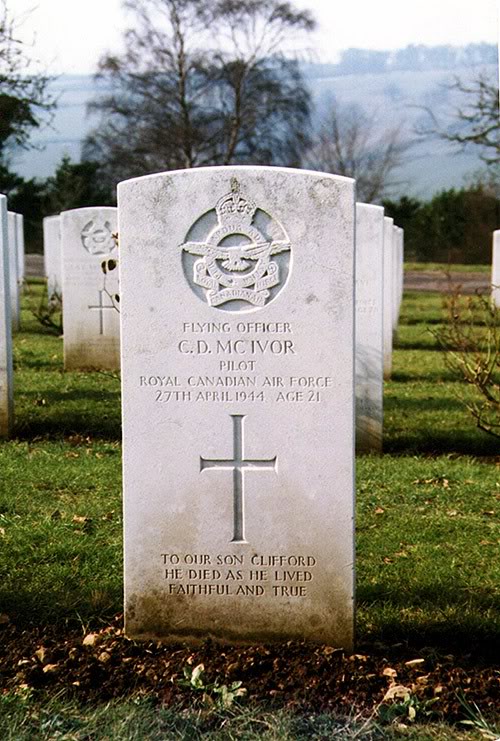
The grave site of Don's last captain, Clifford McIvor, at Bath Cemetery - via "Wellington285"
And the following photos were kindly supplied by Gill Fountain of Don with his old crew mates,
Gill's father George and Alfie King. Don is on the left in both photos
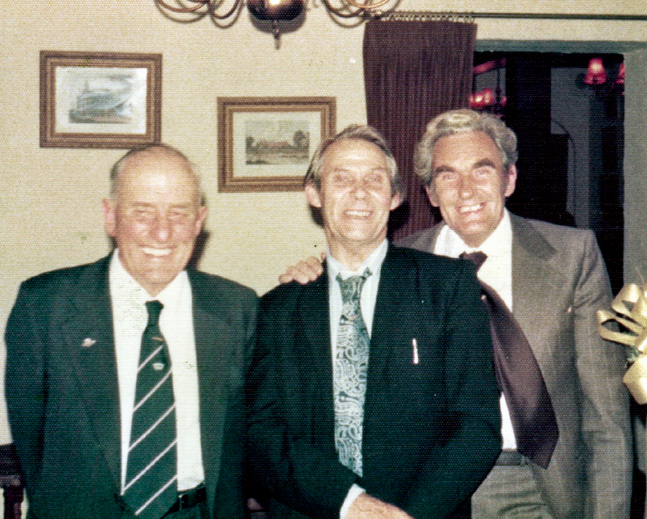
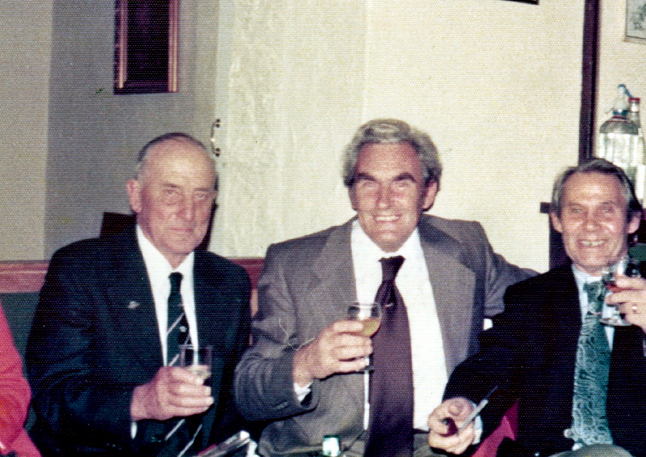
| Home | Airmen | Roll of Honour |
|---|
